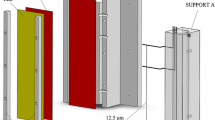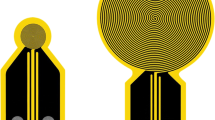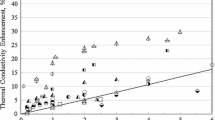Abstract
A novel application of the transient hot-wire technique for thermal conductivity measurements is described. The new application is intended to provide an accurate means of implementation of the method to the determination of the thermal conductivity of solids exemplified by a standard reference ceramic material. The methodology makes use of a soft-solid material between the hot wires of the technique and the solid of interest. Measurements of the transient temperature rise of the wires in response to an electrical heating step in the wires over a period of 20 μs to 10 s allows an absolute determination of the thermal conductivity of the solid. The method is based on a full theoretical model with equations solved by finite-element method applied to the exact geometry. The uncertainty achieved for the thermal conductivity is better than ±1%, and for the product (ρC p) about ±3%. The whole measurement involves a temperature rise less than 4 K.
Similar content being viewed by others
REFERENCES
M. J. Assael, M. Dix, A. Lucas, and W. A. Wakeham, J. Chem. Soc., Faraday Trans. 1 77:439 (1981).
E. Charitidou, M. Dix, M. J. Assael, C. A. Nietode Castro, and W. A. Wakeham, Int. J. Thermophys. 8:511 (1987).
W. A. Wakeham, A. Nagashima, and J. V. Sengers,eds, Experimental Thermodynamics. Vol. III. Measurements of the Transport Properties of Fluids (Blackwell Scientific Publications, London, 1991).
W. E. Haupin, Am. Ceram. Soc. Bull. 39:139 (1960).
A. Von Mittenbühler, Ber. Dtsch.Keram. Ges. 41:15 (1964).
Deutsches Institutfür Normung, Testing of Ceramic Materials: Determination of Thermal Conductivity up to 1600 °C by the Hot-Wire Method. Thermal Conductivity up to 2 W/m/K(in German), DIN 51046 (August 1976).
European Committee for Standardization, Methods of Testing Dense Shaped Refractory Products. Part 14: Determination of Thermal Conductivity by the Hot-Wire (Cross-Array) Method. EN 993-14 (1998).
European Committee for Standardization,Methods of Testing Dense Shaped Refractory Products. Part 15: Determination of Thermal Conductivity by the Hot-Wire (Parallel) Method. EN 993-15 (1998).
L. Vozár, J. Therm. Anal. 46:495 (1996).
G. D. Morrow, Ceram. Bull. 58:687 (1979).
L. Binkele, High Temp.-HighPress. 15:131 (1983).
W. R. Davis and A. M. Downs, Trans. Br. Ceram. Soc. 79:44 (1980).
S.E. Gustafsson, Rev. Sci. Instrum. 62:797 (1991).
M. Dix, I. W. Drummond, M. Lesemann, V. Peralta-Martinez, W. A. Wakeham, M. J. Assael, L. Karagiannidis, and H. R. van den Berg, in Proc. 5th ATPC (Seoul, Korea, 1998), p. 113.
J. Kestin and W. A. Wakeham, Phys. A 92:102 (1978).
M. L. V. Ramires, C. A. Nieto de Castro, R. A. Perkins, Y. Nagasaka, A. Nagashima, M. J. Assael, and W. A. Wakeham, J. Phys. Chem. Ref. Data 29:133 (2000).
Author information
Authors and Affiliations
Rights and permissions
About this article
Cite this article
Assael, M.J., Dix, M., Gialou, K. et al. Application of the Transient Hot-Wire Technique to the Measurement of the Thermal Conductivity of Solids. International Journal of Thermophysics 23, 615–633 (2002). https://doi.org/10.1023/A:1015494802462
Issue Date:
DOI: https://doi.org/10.1023/A:1015494802462




